
Station Name: STANMORE VILLAGE
Stanmore Village Station Gallery 1: 1890 - August 1920 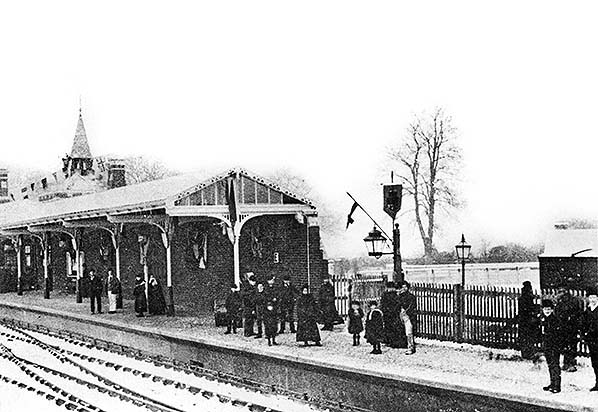 Stanmore station prior to the arrival of the inaugural passenger train on a snowy opening day, Thursday 18 December 1890. The presence of the goods van, right, suggests that goods traffic had already commenced and this was normal practice to allow newly-laid ballast and track to settle. There are some children on the platform, no doubt taken by a parent to witness the historic scene. Many of the other people present would have been railway and other officials and the relatively small crowd, in comparison with other opening day scenes, would be an omen for the future. The station has yet to be transformed by a plethora of colourful advertisements but there are plenty of other decorations, including shields fixed to each canopy stanchion; these would have represented local and county authorities, landowners, financial backers and the railway company. Just visible are the charming lanterns suspended beneath the canopy. In 1890 the area through which the short branch from Harrow passed was still of a rural nature. By the time that residential development had spread to an appreciable level the Metropolitan had opened its station further east on London Road, offering frequent electric trains direct into London. The LNWR Stanmore Branch was thus doomed from the outset although, in fairness, this is easy to judge with the benefit of hindsight. The couple of inches of snow which covered Stanmore would, of course, if occurring today, mean that no trains would be running from Harrow with excuses varying from damage to underfloor equipment of trains to Health & Safety concerns. What is now London Underground would, however, still be operating as would other railways abroad where there was much more snow. As an interesting aside, what is now the Jubilee Line station at Stanmore is not far (about ¾-mile) from what would have been Brockley Hill station on the never-completed Northern Line extension to Bushey Heath. Had it been completed, Stanmore would for a few years have been spoiled with the LNWR and London Road LT stations plus LT's Brockley Hill station serving its eastern fringe. Stanmore station prior to the arrival of the inaugural passenger train on a snowy opening day, Thursday 18 December 1890. The presence of the goods van, right, suggests that goods traffic had already commenced and this was normal practice to allow newly-laid ballast and track to settle. There are some children on the platform, no doubt taken by a parent to witness the historic scene. Many of the other people present would have been railway and other officials and the relatively small crowd, in comparison with other opening day scenes, would be an omen for the future. The station has yet to be transformed by a plethora of colourful advertisements but there are plenty of other decorations, including shields fixed to each canopy stanchion; these would have represented local and county authorities, landowners, financial backers and the railway company. Just visible are the charming lanterns suspended beneath the canopy. In 1890 the area through which the short branch from Harrow passed was still of a rural nature. By the time that residential development had spread to an appreciable level the Metropolitan had opened its station further east on London Road, offering frequent electric trains direct into London. The LNWR Stanmore Branch was thus doomed from the outset although, in fairness, this is easy to judge with the benefit of hindsight. The couple of inches of snow which covered Stanmore would, of course, if occurring today, mean that no trains would be running from Harrow with excuses varying from damage to underfloor equipment of trains to Health & Safety concerns. What is now London Underground would, however, still be operating as would other railways abroad where there was much more snow. As an interesting aside, what is now the Jubilee Line station at Stanmore is not far (about ¾-mile) from what would have been Brockley Hill station on the never-completed Northern Line extension to Bushey Heath. Had it been completed, Stanmore would for a few years have been spoiled with the LNWR and London Road LT stations plus LT's Brockley Hill station serving its eastern fringe.Photo from James Lake collection  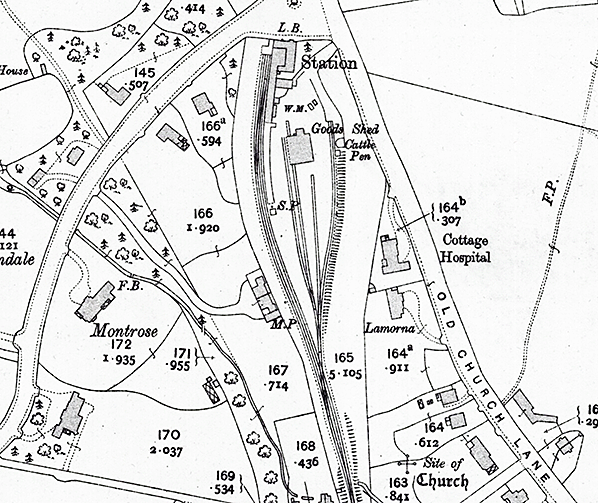
1911 1:2,500 OS map shows the layout of Stanmore Village station as built. The station fronted onto a forecourt at the junction of Gordon Avenue and Station Road. The station building was roughly 'L' shaped with the booking office and ladies’ waiting room facing the forecourt and the general waiting room, gents' toilets and other rooms facing onto the platform. There was a run-round loop opposite the platform road. LB indicates the letter box on the front of the building. There are four sidings fanning out behind the station building. One siding appears to pass thorough the goods shed but it actually passed on the west side of the goods shed but was protected by a timber covering. The easternmost siding served a cattle dock with a cattle pen at its south end. The entrance to the goods yard is in Old Church Lane with a weighbridge and office shown just inside the entrance. At the rear of the station building there is a bicycle store and a few yards to the south a smaller oil store room.
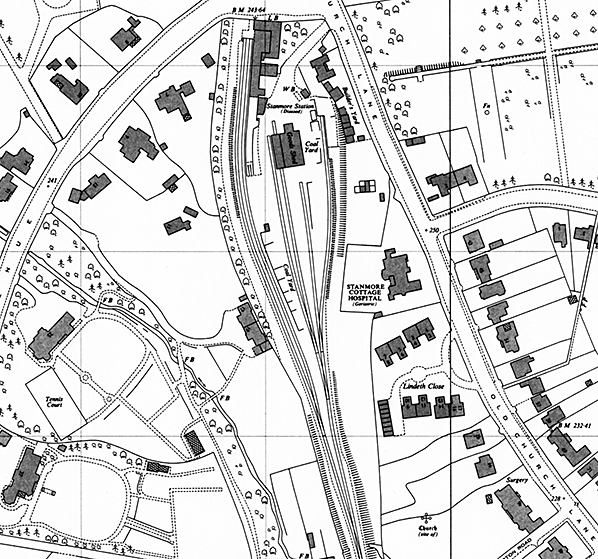
1962 1:2,500 OS map shows the layout of Stanmore Village station after closure to passengers; the station is shown as 'Stanmore Station (Disused). The platform and the canopy have been shortened; this happened before closure to passengers. At this time the goods yard handled only coal traffic. Two coal yards, with coal bins, are shown to the south of the goods shed and immediately east of the goods shed. Further coal bins were located to the east of the short siding. A builder’s yard is shown to the east of the cattle dock. Large quantities of bricks arrived by rail as residential development was underway in the 1930s. Once local building contractor, Henry J Clare, opened an office at the station by 1933; other merchants’ offices were located in the builder’s yard. The building at the entrance to the yard is Franklins Coal Office; this building was originally a cabmen's shelter on the forecourt behind the buffers - although not shown on any maps. Note new houses on the east side of Old Church Lane.
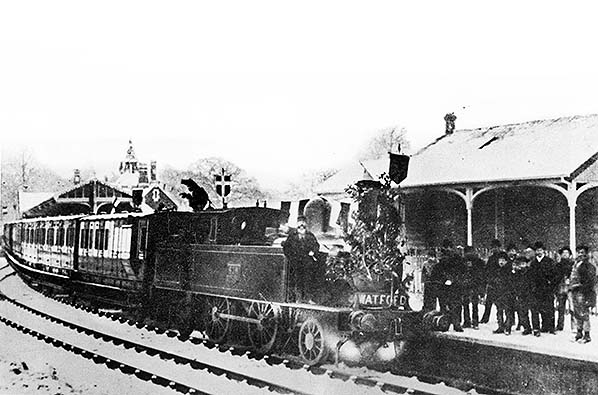 On the opening day to public passenger trains, Thursday 18 December 1890, the inaugural train awaits departure for Watford. Following the locomotive running round, the train has set back towards the buffers. As with the other opening day picture, there is hardly a mass of people present to witness the event. The train appears to comprise all four-wheelers. The semi-decorated locomotive (the shields are on the platform, not the locomotive) is a Webb 4ft 6in 2-4-2T. Its number is unclear but appears to be either 628 or 828. The man standing on the running plate was probably the driver. Unlike the 5ft 6in version, the 4ft 6in 2-4-2T's were relatively short lived and all had gone from the LMS by the mid 1930s. A few were sold, some to industry, one ended up with the GWR and some ended up in Ireland, re-gauged, for example. Stanmore's goods facilities can be seen on the right. Quite what the 'Tyrannosaurus Rex', visible in the background, was doing at Stanmore was not recorded. Perhaps he thought the opening day of the railway might provide some tasty snacks. The Watford destination board is indicative of a major problem with the Stanmore branch in that the junction at Harrow faces north, requiring passengers to and from London to change trains. Through services to and from Euston could have been more conveniently provided by push-and-pull trains but this was never to be and once the Metropolitan station at Stanmore opened it would likely have been pointless anyway. Trains from Stanmore to Watford had to cross the up main line at Harrow and in addition further crossing would have been necessary at Watford, either in the down or up direction. Whilst this probably caused no issues back in 1890 it certainly would have done by the 1940s and today would be dismissed outright.
Photo from James Lake collection old5.jpg)
A delightful postcard view of Stanmore station around the turn of the twentieth century. Note the hanging baskets and newsvendor's kiosk. The present Jubilee Line station at Stanmore had been opened by the Metropolitan Railway in 1932, shortly before the creation of London Transport the following year. The LNWR Stanmore branch had the dubious reputation of never being particularly well used yet prior to the coming on the Metropolitan Railway it was Stanmore's only station so provision of the newsvendor's kiosk must have been considered worthwhile. Later photographs show that the kiosk had been replaced by a simple vending rack. The hanging baskets, colourful advertisements and the leafy surroundings must have created a very pleasant atmosphere. Note also the large advertisement for Whiteley's furniture and the apparent need to travel to Regent Street to have one's dry cleaning done. The Sketchley advertisement does say 'London Office', however, so perhaps there was a local branch. What is being advertised at Crystal Palace cannot be determined. The advertisement partly off the picture on the right presumably advertises Maple's curtains. Maple & Co of Tottenham Court Road was an upmarket furniture maker and retailer dating back to the early nineteenth century. Once the largest such company in the world, Maple & Co eventually disappeared through a series of takeovers and mergers towards the end of the twentieth century. The building behind the buffers is a cabmen's shelter.
Copyright photo from John Alsop collection old10.jpg)
The church-like station building at Stanmore in the early years of the twentieth century. Note the unusual quatrefoil window to the right. Behind the camera is what was then Station Road, with Old Church Lane off to the left and Gordon Avenue off to the right. Station Road is today part of Old Church Lane. Much of the signwriting on the horse-drawn delivery van is discernible on enlargement. At the top is 'Daily Deliveries To' followed by a list of place names which include Elstree, Boreham Wood, Arkley, Barnet, Northaw, Potters Bar etc. At the bottom is the name William Whiteley Ltd and this refers to the well-known but now defunct department store originally on Westbourne Grove and later nearby on Queen's Road, now Queensway. Whether the delivery van was owned by Whiteley's or it merely carries an advertisement for them is unclear but as there is no other obvious trading name visible it likely belonged to them. Whiteley's was reputedly London's first department store and for a few years held a Royal Warrant bestowed by Queen Victoria. William Whiteley himself was destined to be murdered in 1907. Note the gas lamps with their square casements.
Copyright photo from John Alsop collection old7.jpg)
A push-and-pull train, or 'Motor Train' as the LNWR seems to have preferred, waits at Stanmore in, it is believed, 1910. The LNWR had introduced push-and-pull trains a couple of years previously and the vehicles involved were converted from pre-existing steam-hauled stock as was common practice. Vehicles converted to driving trailers were a motley collection of various types; some were brake-end vehicles with a cab added at the brake end, some were centre-brakes while others were basic non-brake vehicles with an end compartment converted to a driving cab and that seen here at Stanmore was of the latter type. The brake compartment of this 2-car set appears to be at the inner end of the second vehicle. The train is set for departure back to Harrow, tail lamp in place, but there is somebody, visible on a larger version of the image, in the driving cab with a hand on what is probably the brake. A few of these vehicles also had a driving cab at both ends but either way when viewed from the side they were difficult to distinguish from their conventional counterparts. Livery appears to be standard LNWR plum and white or, more properly, 'Carriage Lake and Coach White'. The ground signal was probably a points indicator, the points for the run-round loop being out of view beneath the train. Apart from being, of course, a tank, the locomotive is unidentified. Its numberplate is visible of the side of the tank in the usual LNWR fashion. Among the platform furniture is the newsvendor's kiosk and a dispensing machine, probably for chocolate. Due to the camera angle only a few of the many advertisements and posters can be discerned. At far left, on or against the end wall, is a joint Lancashire & Yorkshire, London & North Western and Midland Railways poster advising of ticket availability. Above this is a LNWR notice concerning 'Passengers Personal Luggage'. The Bibby's advertisement states 'Bibby's Cream Equivalent - The Best of All Calf Foods'. Higher up on the end wall and half off the picture is an advertisement for Foster & Co. Ltd. of Kilburn. Presumably Foster's were outfitters as a second advertisement, facing the platform, states 'Everything For Boys Wear'. Of the three posters at bottom left and facing the platform, one is promoting a show of some description at Watford. Above it, the three small and identical advertisements appear to promoting tea, or something for tea, but are otherwise unreadable.
Copyright photo from John Alsop collection old16.jpg) A further view of Stanmore station with what was then Station Road behind the camera. Although another early twentieth century view, this one is a little later than the postcard view showing the Whiteley's van. The only change to note is the different gas lamp casements, now of the more familiar tapered type. During this period there was no obvious signage indicating this was a railway station, although Station Road would have offered a clue and no doubt 'Stanmore Station' was given on the letterbox as its location. Lack of signage would not, however, have been a problem for local people. Two horse-drawn cabs are waiting for passengers.
Photo from John Mann collection old12.jpg) Stanmore station looking south from the buffers in August 1920; the pronounced curve in the platform is clearly visible. The two doorways either side of the newsvendor's kiosk are not identified; general waiting room and gents' toilet were entered from the platform. Stanmore station looking south from the buffers in August 1920; the pronounced curve in the platform is clearly visible. The two doorways either side of the newsvendor's kiosk are not identified; general waiting room and gents' toilet were entered from the platform.Photo from John Mann collection
|
 Notes: Stanmore Station was sited about ¼-mile from the village centre and, at the insistence of Great Stanmore Parish Council, the building was designed to blend in with its affluent surroundings. It consisted of a brick-and-tile building with freestone embellishments resembling a small Gothic country church. Its principal feature was a square tower with gargoyles possessing a spire, stone-faced clock and buttressed portico; its entrance door even resembled that of a church. No signs were displayed on the front of the station building until British Railways took over. In LMS days a sign was fixed to the fence between the station building and Old Church Lane. The misleading sign stated: 'STANMORE L.MS STATION - FREQUENT TRAINS TO ALL PARTS OF LONDON AND THE NORTH' The station had a single platform 310ft in length, protected for most of its length by a cast-iron and glass awning supported by stanchions bearing the arms of the Gordon family: three boars' heads surrounded by thistles and roses. Facing the platform was a locomotive run-round road; behind it, on the east side, were a goods shed and four sidings. Other structures in the goods yard included a goods office, weighbridge and office, bicycle shed, loading bay and two banks of coal staiths
Notes: Stanmore Station was sited about ¼-mile from the village centre and, at the insistence of Great Stanmore Parish Council, the building was designed to blend in with its affluent surroundings. It consisted of a brick-and-tile building with freestone embellishments resembling a small Gothic country church. Its principal feature was a square tower with gargoyles possessing a spire, stone-faced clock and buttressed portico; its entrance door even resembled that of a church. No signs were displayed on the front of the station building until British Railways took over. In LMS days a sign was fixed to the fence between the station building and Old Church Lane. The misleading sign stated: 'STANMORE L.MS STATION - FREQUENT TRAINS TO ALL PARTS OF LONDON AND THE NORTH' The station had a single platform 310ft in length, protected for most of its length by a cast-iron and glass awning supported by stanchions bearing the arms of the Gordon family: three boars' heads surrounded by thistles and roses. Facing the platform was a locomotive run-round road; behind it, on the east side, were a goods shed and four sidings. Other structures in the goods yard included a goods office, weighbridge and office, bicycle shed, loading bay and two banks of coal staiths A number of films were made at Stanmore including The Gold Express in 1955 and a BBC television play, The Sun and I in 1955 and for this the station was renamed 'Harley'. On 26 April 1959, the Harrow Sub-Division of the Middlesex Division of the Civil Defence Corps staged exercise 'Rocket' at the station based on the idea that a nuclear bomb had exploded at Chingford and Harrow was in the badly damaged area. A train 'passing through' Stanmore had been affected by the blast and there were 80 casualties in the three coaches. The exercise was staged on the loop road opposite the passenger platform.
A number of films were made at Stanmore including The Gold Express in 1955 and a BBC television play, The Sun and I in 1955 and for this the station was renamed 'Harley'. On 26 April 1959, the Harrow Sub-Division of the Middlesex Division of the Civil Defence Corps staged exercise 'Rocket' at the station based on the idea that a nuclear bomb had exploded at Chingford and Harrow was in the badly damaged area. A train 'passing through' Stanmore had been affected by the blast and there were 80 casualties in the three coaches. The exercise was staged on the loop road opposite the passenger platform. The entrance portico with its stone buttressing, the clock above it and the four decorative gargoyles on the tower were removed shortly after closure to passengers. For a while the redundant station building was rented to a potato merchant. After closure to all traffic the last train left Stanmore Village on 21 August 1964 loaded with asbestos cable ducts that had been stored at the station. The track was lifted in September 1964. The station buildings deteriorated rapidly owing to continual vandalism. The roof tiles above the booking hall and adjacent ladies’ waiting room were all stolen. In an attempt to prevent access to the building the windows and doors were boarded up but this did little to prevent children from getting in. The bicycle shed, a store and the goods shed were all damaged by fire. The goods shed was completely gutted leaving little more than a brick shell and part of the timber covering over the shed road.
The entrance portico with its stone buttressing, the clock above it and the four decorative gargoyles on the tower were removed shortly after closure to passengers. For a while the redundant station building was rented to a potato merchant. After closure to all traffic the last train left Stanmore Village on 21 August 1964 loaded with asbestos cable ducts that had been stored at the station. The track was lifted in September 1964. The station buildings deteriorated rapidly owing to continual vandalism. The roof tiles above the booking hall and adjacent ladies’ waiting room were all stolen. In an attempt to prevent access to the building the windows and doors were boarded up but this did little to prevent children from getting in. The bicycle shed, a store and the goods shed were all damaged by fire. The goods shed was completely gutted leaving little more than a brick shell and part of the timber covering over the shed road. In April 1967 a local committee was formed to look into the possibility of renovating the station as a visual arts centre and railway museum. Some maintenance work was carried out but despite newly erected 'no trespassing' signs and regular inspections the vandalism continued and when Harrow Council failed to offer its support the committee was disbanded. In 1969 the site was sold to a local developer. Efforts to obtain a preservation order for the station building failed. In June 1970 planning permission was granted for the conversion of the station building into a dwelling. The part of the building fronting onto Station Road that had previously housed the booking office and ladies’ waiting room was gutted to create three garages. Although some features like the door frame, window frames and the quatrefoil window were retained, all the bricks were hacked out and the building was faced with new bricks. The original roof and the top half of the tower and the oak spire were removed. A new roof was built incorporating a single-bedroom flat. The remaining part of the building to the rear of the booking office was demolished. The rest of the station and goods area were cleared in July 1970 to make way for a new housing development named September Way.
In April 1967 a local committee was formed to look into the possibility of renovating the station as a visual arts centre and railway museum. Some maintenance work was carried out but despite newly erected 'no trespassing' signs and regular inspections the vandalism continued and when Harrow Council failed to offer its support the committee was disbanded. In 1969 the site was sold to a local developer. Efforts to obtain a preservation order for the station building failed. In June 1970 planning permission was granted for the conversion of the station building into a dwelling. The part of the building fronting onto Station Road that had previously housed the booking office and ladies’ waiting room was gutted to create three garages. Although some features like the door frame, window frames and the quatrefoil window were retained, all the bricks were hacked out and the building was faced with new bricks. The original roof and the top half of the tower and the oak spire were removed. A new roof was built incorporating a single-bedroom flat. The remaining part of the building to the rear of the booking office was demolished. The rest of the station and goods area were cleared in July 1970 to make way for a new housing development named September Way. 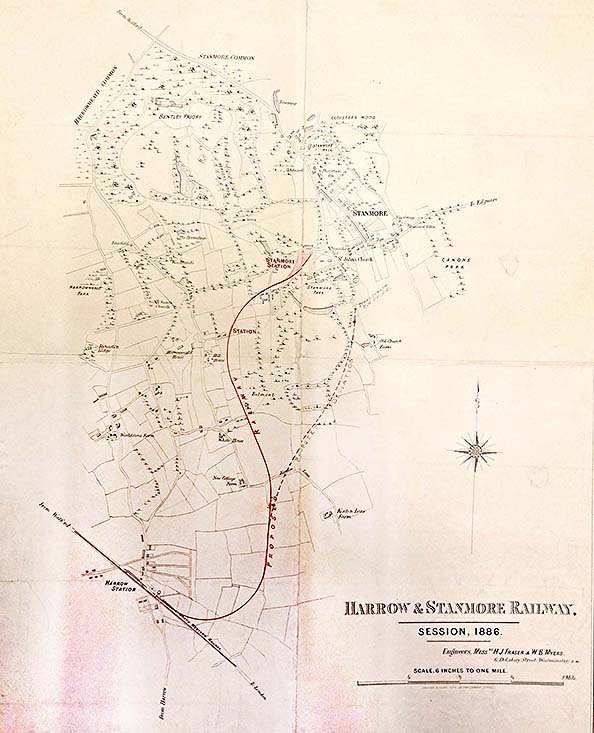
 After failing to raise sufficient capital, Gordon proposed a second Bill in 1887 for a shorter 2⅛-mile route from a junction with the London & North Western Railway at Harrow & Wealdstone to a terminus at Stanmore. By a further Act in 1891 the LNWR agreed to work the short branch with the Harrow & Stanmore Railway building and maintaining a single-track line with a passenger and goods station at Stanmore and interchange sidings at Harrow. The Act also allowed for an intermediate station if requested by the LNWR. After one year the LNWR agreed to take over maintenance and repair of the line.
After failing to raise sufficient capital, Gordon proposed a second Bill in 1887 for a shorter 2⅛-mile route from a junction with the London & North Western Railway at Harrow & Wealdstone to a terminus at Stanmore. By a further Act in 1891 the LNWR agreed to work the short branch with the Harrow & Stanmore Railway building and maintaining a single-track line with a passenger and goods station at Stanmore and interchange sidings at Harrow. The Act also allowed for an intermediate station if requested by the LNWR. After one year the LNWR agreed to take over maintenance and repair of the line.
 In 1912 Harrow & Wealdstone Station was rebuilt as part of the LNWR widening and suburban electrification scheme. The branches from Watford to Croxley Green and Rickmansworth were both electrified but because of the position of the junction the Stanmore branch was not included which, in the long run, contributed to the demise of the line after the Metropolitan Railway (now the Jubilee line) opened their line to Stanmore on 10 December 1932 once urban development reached the area.
In 1912 Harrow & Wealdstone Station was rebuilt as part of the LNWR widening and suburban electrification scheme. The branches from Watford to Croxley Green and Rickmansworth were both electrified but because of the position of the junction the Stanmore branch was not included which, in the long run, contributed to the demise of the line after the Metropolitan Railway (now the Jubilee line) opened their line to Stanmore on 10 December 1932 once urban development reached the area. Passenger numbers improved in the 1930s when urban development finally reached the area between Harrow and Stanmore. To cater for this, the LMSR opened a wooden halt at Belmont on 12 September 1932, on the site of the former Kenton Lane siding, to serve a planned housing estate. Although the Metropolitan line from Wembley Park reached Stanmore shortly after Belmont opened fares were cheaper from Belmont and the new station attracted commuters. A Sunday service was introduced in 1934 and in order to cater for the added demand, Belmont was rebuilt in 1937. In 1938 the service had increased to 71 trains in each direction on weekdays with a ten-minute interval during rush hours. Freight traffic also improved; with the ongoing urban development there was a demand for large quantities of bricks which were delivered to the yard at Stanmore and eventually a temporary siding was laid at Belmont to cater for some of this traffic.
Passenger numbers improved in the 1930s when urban development finally reached the area between Harrow and Stanmore. To cater for this, the LMSR opened a wooden halt at Belmont on 12 September 1932, on the site of the former Kenton Lane siding, to serve a planned housing estate. Although the Metropolitan line from Wembley Park reached Stanmore shortly after Belmont opened fares were cheaper from Belmont and the new station attracted commuters. A Sunday service was introduced in 1934 and in order to cater for the added demand, Belmont was rebuilt in 1937. In 1938 the service had increased to 71 trains in each direction on weekdays with a ten-minute interval during rush hours. Freight traffic also improved; with the ongoing urban development there was a demand for large quantities of bricks which were delivered to the yard at Stanmore and eventually a temporary siding was laid at Belmont to cater for some of this traffic.
 The branch survived WW2 with only a short disruption to the service when a bomb left a crater near the track. In 1946 there was a fuel shortage and the Sunday service which had initially been very popular was temporarily suspended. When it was reinstated most passengers had found alternative means of transport and never returned to the railway so the Sunday service was permanently withdrawn from 27 July 1947. Although Belmont remained busy and was now the principal station on the line few passengers used the terminus at Stanmore and in 1952; the average daily usage was only 700 so it came as no surprise when BR announced closure of the branch which was making an annual loss of £4000. There was a robust campaign by residents of Belmont to keep their section of the line open; this was successful and from 15 September 1952 the passenger service was cut back to Belmont. Stanmore remained open being served by a daily freight train.
The branch survived WW2 with only a short disruption to the service when a bomb left a crater near the track. In 1946 there was a fuel shortage and the Sunday service which had initially been very popular was temporarily suspended. When it was reinstated most passengers had found alternative means of transport and never returned to the railway so the Sunday service was permanently withdrawn from 27 July 1947. Although Belmont remained busy and was now the principal station on the line few passengers used the terminus at Stanmore and in 1952; the average daily usage was only 700 so it came as no surprise when BR announced closure of the branch which was making an annual loss of £4000. There was a robust campaign by residents of Belmont to keep their section of the line open; this was successful and from 15 September 1952 the passenger service was cut back to Belmont. Stanmore remained open being served by a daily freight train.
 The first few chains out of Harrow were retained until 1968 as a headshunt for the Harrow goods yard and a test track for tamping machines. On 9 June 1965 the branch came back to life for one day when it was used by the BBC for an episode of The Londoners TV series with a two-car train shuttling up and down the branch all day. Only one other train went beyond the ¼-mile post when a weed-killing train visited the branch on 25 June 1965.
The first few chains out of Harrow were retained until 1968 as a headshunt for the Harrow goods yard and a test track for tamping machines. On 9 June 1965 the branch came back to life for one day when it was used by the BBC for an episode of The Londoners TV series with a two-car train shuttling up and down the branch all day. Only one other train went beyond the ¼-mile post when a weed-killing train visited the branch on 25 June 1965. 
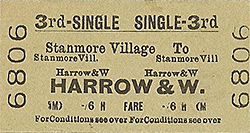

 Home Page
Home Page